Three-Dimensional Turbulent Simulation of Bivariate Normal Distribution Protection Device
Abstract
:1. Introduction
2. Protection Device in the Shape of a Bivariate Normal Distribution (BND)
3. Three-Dimensional Turbulent Mathematical Model of BND
3.1. Control Equations
3.2. Geometric Model and Mesh
3.3. Mathematical Simulation Scheme
3.4. Validation of the Mathematical Model Based on Experiments
3.5. Grid Independence Verification
4. Turbulent Characteristics of the BND
4.1. Analysis of Velocity Characteristics
4.2. Vorticity Field Analysis
4.3. Analysis of Bed Shear Stress
5. The Influence of the Width of the BND
6. Discussion
- (1)
- With known parameters for the water flow, sediment, and bridge pier, we use existing empirical formulas or experimental data to calculate the maximum possible scour depth (dse).
- (2)
- We determine the height of the BND. If the actual scour hole has not reached the calculated value, we take the calculated height 0.7 des as the dimensional height of H/D. If the actual scour depth is greater than the calculated value, we take the actual value. However, the design value is generally larger.
- (3)
- We calculate the parameters k and for the BND.
7. Conclusions
- (1)
- For the first time, a three-dimensional turbulent mathematical model for the protective surface around bridge piers was established. The three-dimensional water flow within the conical surface was observed in the flume, verifying the accuracy of the mathematical model, which can be used to simulate and analyze the longitudinal velocity, downflow, vorticity intensity, and shear stress within the BND.
- (2)
- Numerical simulations show that the range of influence of the longitudinal water flow on both sides of the pier is within 5D, with the maximum longitudinal velocity occurring at a distance of 0.08D from the pier. The maximum velocity of the downflow in front of the pier is about 0.7, with a vertical distribution within and a longitudinal range . The upper part of the downflow velocity distribution has little difference, while the lower part shows significant differences in the water flow structure. The surface can isolate the downflow from the bed to prevent scouring.
- (3)
- The maximum shear stress coefficients within the conical and BNDs reach 12 and 9, and the protective surface can prevent the bed from being scoured by high shear stress. The edge velocity gradient of the BND is less than that of the conical surface, with a shear stress amplification factor of only one-third of the conical surface, and the maximum at the rear edge of the surface is two, with an area of only 4 cm2.
- (4)
- The vorticity intensity in front of the pier within the BND is significantly reduced, with a non-dimensional vortex flux of 0.2, which is 33% lower than that of the conical surface. The water flow in the BND transitions smoothly, with a gradual boundary layer separation, no spanwise vortices at the outer edge, and weak scouring effects; in contrast, the conical surface has obvious spanwise vortices at the outer edge, with a Q value of 8, which is prone to edge scouring.
- (5)
- Numerical simulations were conducted to analyze the lateral distribution of longitudinal velocity and the variation in shear stress under different widths of the BND. The results show that the maximum longitudinal velocity is 1.15~1.23 times the incoming flow velocity, and the velocity gradually decreases along the lateral direction. When y < 1.66D, the longitudinal velocity increases with the increase in the surface width W; after y > 1.66D, the velocity change slows down. The extreme value of the bed shear stress coefficient decreases monotonically with the increase in W, and the areas on both sides are significantly reduced. When W 3.5D, the maximum shear stress coefficient on the rear side of the surface is small, and the distribution area of is very small. When W = 4D, the distribution area of is almost zero.
Author Contributions
Funding
Institutional Review Board Statement
Informed Consent Statement
Data Availability Statement
Conflicts of Interest
References
- Singh, N.B.; Devi, T.T.; Kumar, B. The local scour around bridge piers—A review of remedial techniques. ISH J. Hydraul. Eng. 2022, 28, 527–540. [Google Scholar] [CrossRef]
- Ramos, P.X.; Bento, A.M.; Maia, R.; Pêgo, J.P. Characterization of the scour cavity evolution around a complex bridge pier. J. Appl. Water Eng. Res. 2016, 4, 128–137. [Google Scholar] [CrossRef]
- Wang, L.; Rui, S.; Guo, Z.; Gao, Y.; Zhou, W.; Liu, Z. Seabed trenching near the mooring anchor: History cases and numerical studies. Ocean Eng. 2020, 218, 108233. [Google Scholar] [CrossRef]
- Chiew, Y.M.; Melville, B.W. Local scour around bridge piers. J. Hydraul. Res. 1987, 25, 15–26. [Google Scholar] [CrossRef]
- Simarro, G.; Teixeira, L.; Cardoso, A.H. Flow Intensity Parameter in Pier Scour Experiments. J. Hydraul. Eng. 2007, 133, 1261–1264. [Google Scholar] [CrossRef]
- Yang, Y.; Melville, B.W.; Macky, G.H.; Shamseldin, A.Y. Temporal Evolution of Clear-Water Local Scour at Aligned and Skewed Complex Bridge Piers. J. Hydraul. Eng. 2020, 146, 1–15. [Google Scholar] [CrossRef]
- Bento, A.M.; Viseu, T.; Pêgo, J.P.; Couto, L. Experimental characterization of the flow field around oblong bridge piers. Fluids 2021, 6, 370. [Google Scholar] [CrossRef]
- Ren, M.; Xu, Z.; Su, G. Calculation and comparative analysis of bridge backwater based on two-dimensional hydrodynamic model and empirical formula. J. Hydroelectr. Power 2017, 36, 78–87. (In Chinese) [Google Scholar]
- Salaheldein, T.M.; Imran, J.; Chaudhry, M.H. Numerical Modeling of Three-Dimensional Flow Field Around Circular Piers. J. Hydraul. Eng. 2004, 130, 91–100. [Google Scholar] [CrossRef]
- Kitsikoudis, V.; Kirca, V.O.; Yagci, O.; Celik, M.F. Clear-water scour and flow field alteration around an inclined pile. Coast. Eng. 2017, 129, 59–73. [Google Scholar] [CrossRef]
- Roulund, A.; Sumer, B.M.; Fredsøe, J.; Michelsen, J. Numerical and experimental investigation of flow and scour around a circular pile. J. Fluid Mech. 2005, 534, 351–401. [Google Scholar] [CrossRef]
- Chiew, Y.M. Scour protection at bridge piers. J. Hydraul. Eng. 1992, 118, 1260–1269. [Google Scholar] [CrossRef]
- Pizarro, A.; Manfreda, S.; Tubaldi, E. The science behind scour at bridge foundations: A review. Water 2022, 12, 374. [Google Scholar] [CrossRef]
- Masjedi, A.; Bejestan, M.S.; Esfandi, A. Reduction of local scour at a bridge pier fitted with a collar in a 180 degree flume bend. J. Hydrodyn. 2010, 22, 669–673. [Google Scholar] [CrossRef]
- Etema, R.; Nakato, T.; Muste, M. An Illustrated Guide for Monitoring and Protecting Bridge Waterways Against Scour. IIHR Technical Report, TR-515 (Final Report); Bridge Piers; March 2006; pp. 1–184. Available online: https://publications.iowa.gov/3752/ (accessed on 23 March 2024).
- Mou, X.; Qiao, C.; Ji, H. Experimental study on a new type of protection combined with annular airfoil anti-impact plate and slit on pier. J. Hydroelectr. Eng. 2017, 36, 26–37. (In Chinese) [Google Scholar]
- Sun, D.; Song, Y.; Cheng, L.; Wang, P. Study on local scour of shallow foundation bridge with protective dam downstream. J. Hydroelectr. Eng. 2007, 6, 83–87. (In Chinese) [Google Scholar]
- Tafarojnoruz, A.; Gaudio, R.; Calomino, F. Evaluation of flow-altering countermeasures against bridge pier scour. J. Hydraul. Eng. 2012, 138, 297–305. [Google Scholar] [CrossRef]
- Tafarojnoruz, A.; Gaudio, R.; Dey, S. Flow-altering countermeasures against scour at bridge piers: A review. J. Hydraul. Res. 2010, 48, 441–452. [Google Scholar] [CrossRef]
- Qi, H.; Yuan, T.; Zou, W.; Tian, W.; Li, J. Numerical Study on Local Scour Reduction around Two Cylindrical Piers Arranged in Tandem Using Collars. Water 2023, 15, 4079. [Google Scholar] [CrossRef]
- Mashahir, M.B.; Zarrati, A.R.; Mokallaf, E. Application of Riprap and Collar to Prevent Scouring around Rectangular Bridge Piers. J. Hydraul. Eng. 2020, 136, 183–187. [Google Scholar] [CrossRef]
- Pandey, M.; Azamathulla, H.M.; Chaudhuri, S.; Pu, J.H.; Pourshahbaz, H. Reduction of time-dependent scour around piers using collars. Ocean Eng. 2020, 213, 107692. [Google Scholar] [CrossRef]
- Alabi, P.D. Time Development of Local Scour at a Bridge Pier Fitted with a Collar. Master’s Thesis, University of Saskatchewan, Saskatoon, SK, Canada, 2006. [Google Scholar]
- Tang, Z.; Melville, B.; Shamseldin, A.; Guan, D.; Singhal, N.; Yao, Z. Experimental study of collar protection for local scour reduction around offshore wind turbine monopile foundations. Coast. Eng. 2023, 183, 104324. [Google Scholar] [CrossRef]
- Chen, S.-C.; Tfwala, S.; Wu, T.-Y.; Chan, H.-C.; Chou, H.-T. A Hooked-Collar for Bridge Piers Protection: Flow Fields and Scour. Water 2018, 10, 1251. [Google Scholar] [CrossRef]
- Valela, C.; Nistor, I.; Rennie Colin, D.; Lara Javier, L.; Maza, M. Hybrid Modeling for Design of a Novel Bridge Pier Collar for Reducing Scour. J. Hydraul. Eng. 2020, 147, 04021012. [Google Scholar] [CrossRef]
- Valela, C.; Rennie, C.D.; Nistor, I. Improved bridge pier collar for reducing scour. Int. J. Sediment Res. 2022, 37, 37–46. [Google Scholar] [CrossRef]
- Kassem, H.; El-Masry, A.A.; Diab, R. Influence of collar’s shape on scour hole geometry at circular pier. Ocean Eng. 2023, 287, 115791. [Google Scholar] [CrossRef]
- Bento, A.M.; Pêgo, J.P.; Viseu, T.; Couto, L. Scour development around an oblong bridge pier: A numerical and experimental study. Water 2023, 15, 2867. [Google Scholar] [CrossRef]
- Ettema, R.; Constantinescu, G.; Melville, B.W. Flow-field complexity and design estimation of pier-scour depth: Sixty years since Laursen and Toch. J. Hydraul. Eng. 2017, 143, 03117006. [Google Scholar] [CrossRef]
- Zhejiang University. Pier Scour Protection Method by Combining a Downward Bivariate Normal Distribution Surface and Granular Mixture; CN202120077345.2 [P]; Zhejiang University: Zhejiang, China, 2022. (In Chinese) [Google Scholar]
- Richardson, E.V.; Davis, S.R. Hydraulic Engineering Circular No.18 (HEC-18). In Evaluating Scour at Bridges; No. FHWA: NHI01-001; Federal Highway Adiminstration: Washington, DC, USA, 2001. [Google Scholar]
- Arneson, L.A.; Zevenbergen, L.W.; Lagasse, P.F.; Davis, S.R. Hydraulic Engineering Circular No. 18 (HEC-18). In Evaluating Scour at Bridges, 5th ed.; No. FHWA-HIF-12-003; Federal Highway Adiminstration: Washington, DC, USA, 2003. [Google Scholar]
- Batchelor, G.K. An Introduction to Fluid Dynamics; Cambridge University Press: Cambridge, UK, 1967. [Google Scholar]
- Wu, Y.; Ren, H.; Xia, J. Applicability of typical turbulence models to the simulation of flow around a cylinder. J. Hydroelectr. Eng. 2017, 36, 50–58. (In Chinese) [Google Scholar]
- Menter, F.R. Two-equation eddy-viscosity turbulence models for engineering applications. AIAA J. 1994, 32, 1598–1605. [Google Scholar] [CrossRef]
- Soulsby, R.L. The Bottom Boundary Layer of Shelf Seas. Elsevier Oceanogr. Ser. 1983, 35, 189–266. [Google Scholar]
- Yagci, O.; Celik, M.F.; Kitsikoudis, V.; Kirca, V.O.; Hodoglu, C.; Valyrakis, M.; Duran, Z.; Kaya, S. Scour patterns around isolated vegetation elements. Adv. Water Resour. 2016, 97, 251–265. [Google Scholar] [CrossRef]
- Pandey, M.; Valyrakis, M.; Qi, M.; Sharma, A.; Lodhi, A.S. Experimental assessment and prediction of temporal scour depth around a spur dike. Int. J. Sediment Res. 2021, 36, 17–28. [Google Scholar] [CrossRef]
- Sun, Z.; Yu, G.; Xu, D.; Ma, G. Three-dimensional flow numerical simulation of normal curved spur dike. J. Zhejiang Univ. (Eng. Ed.) 2016, 50, 1247–1251. [Google Scholar]
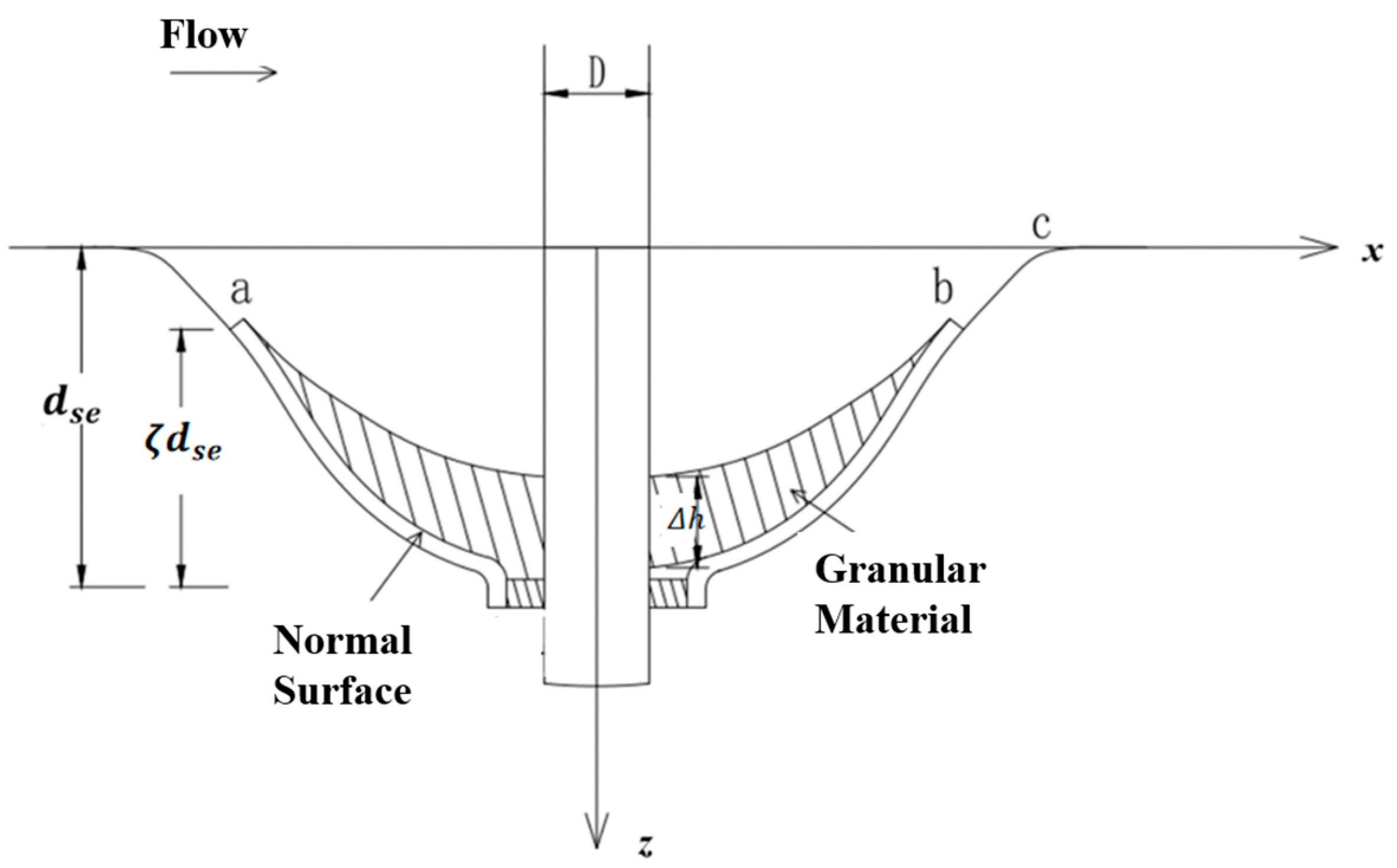
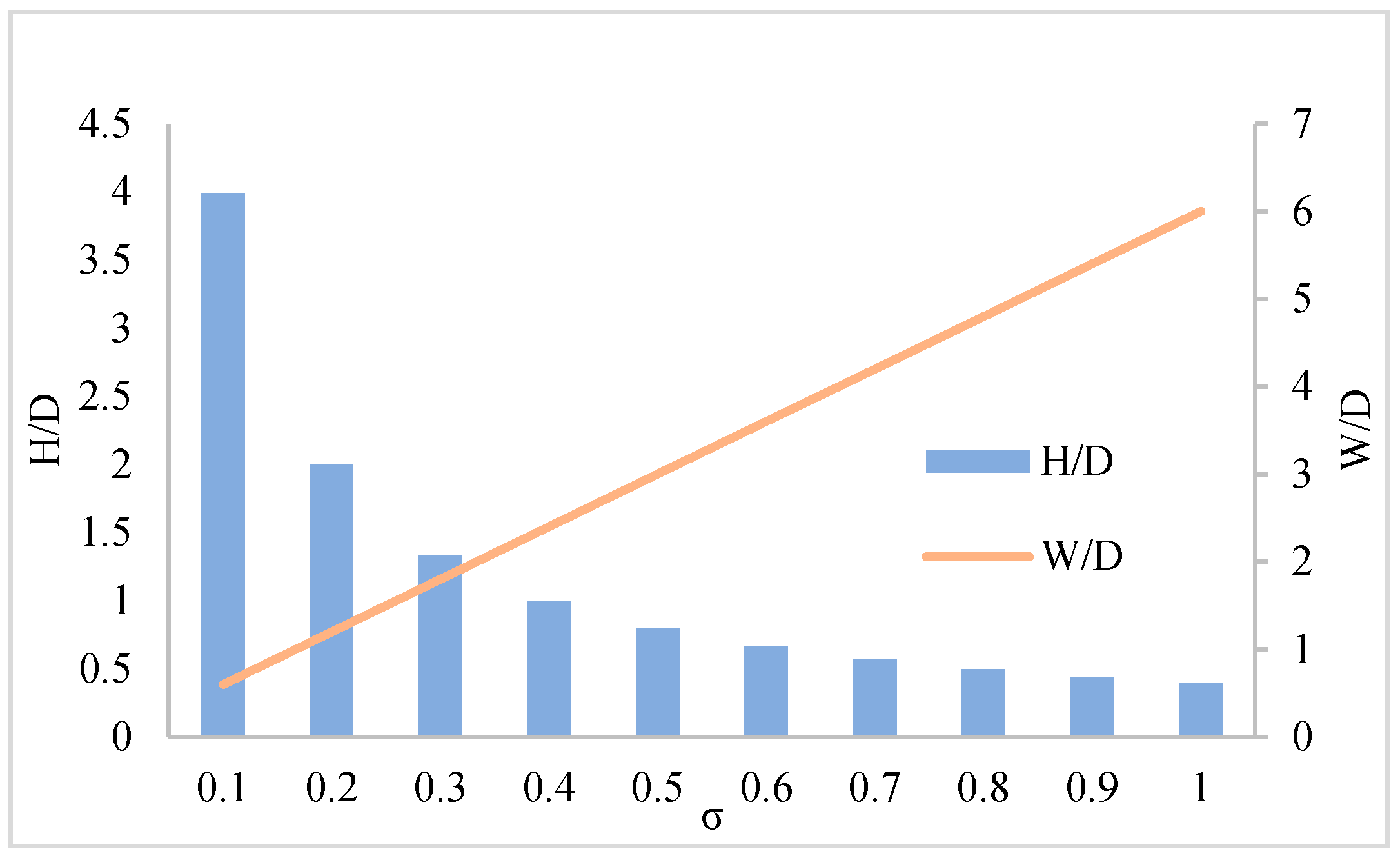
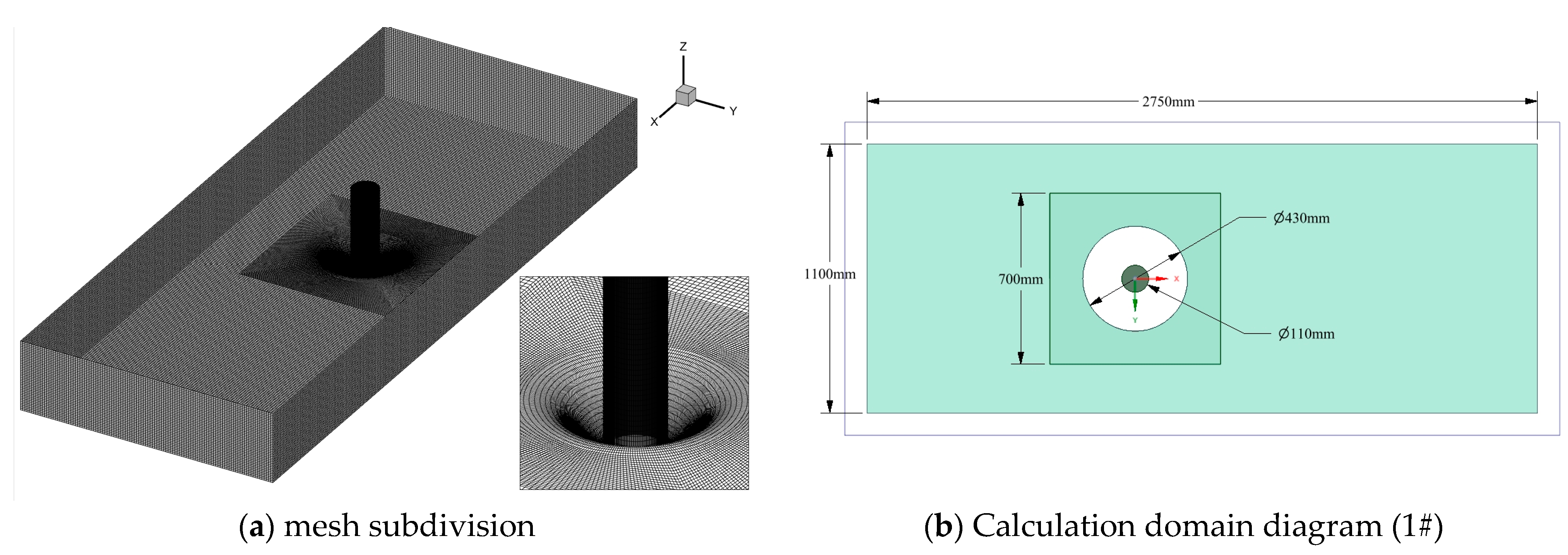



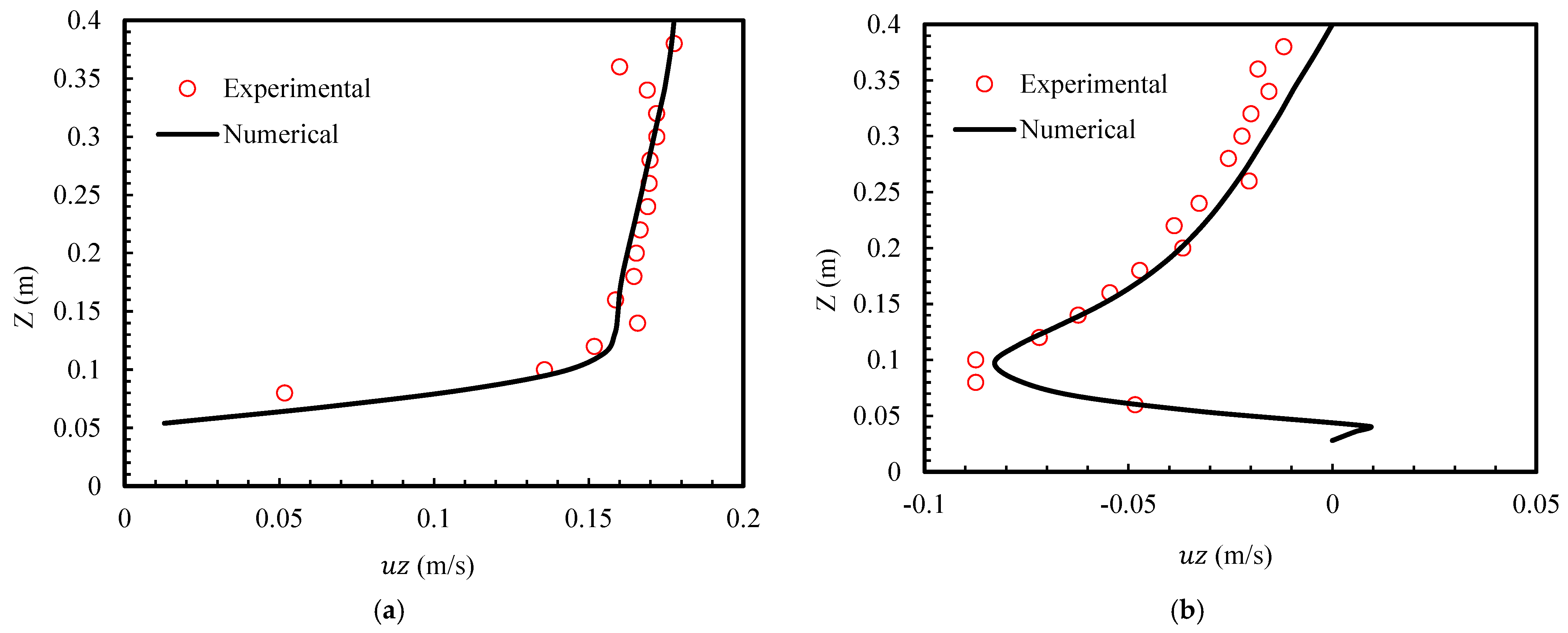
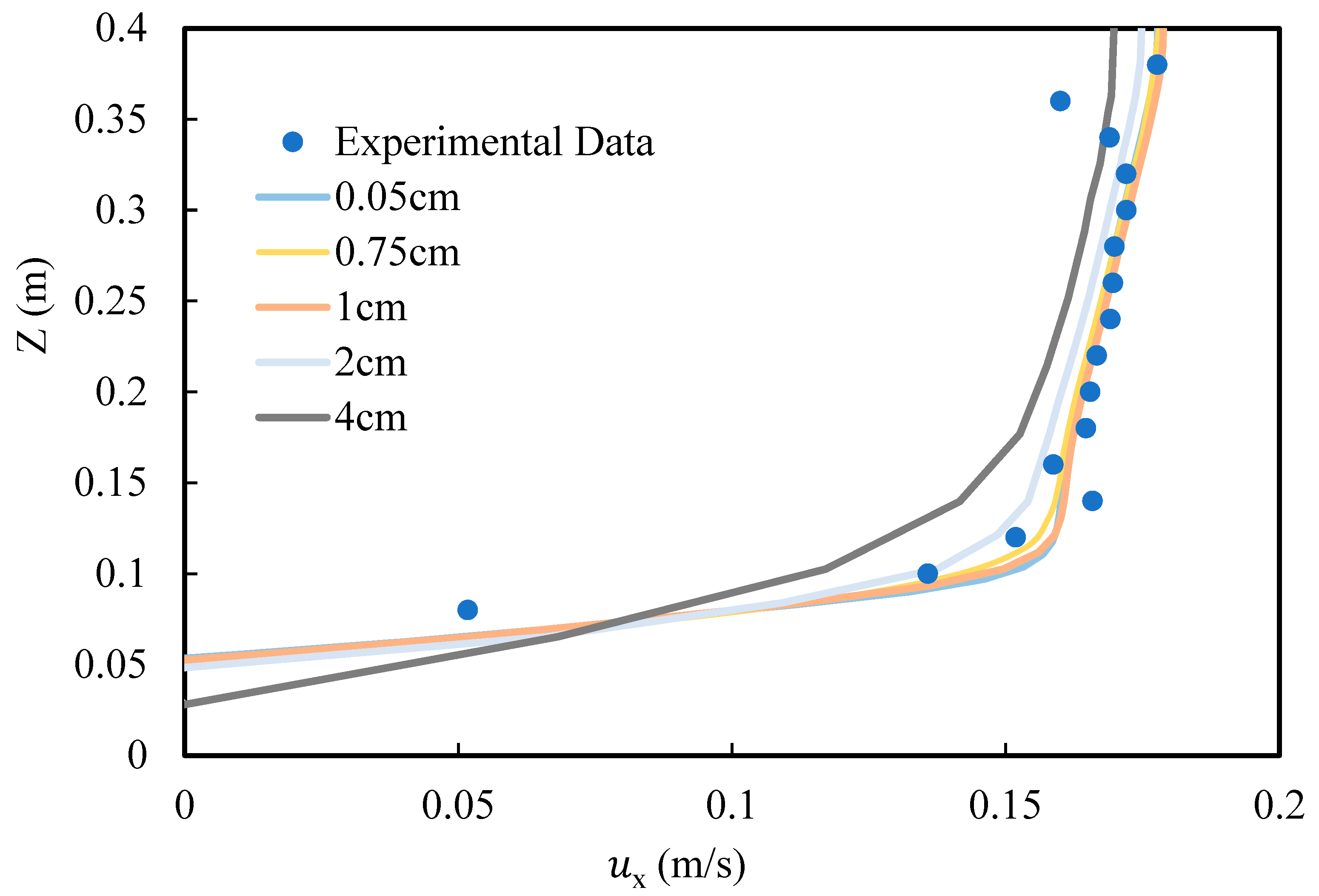

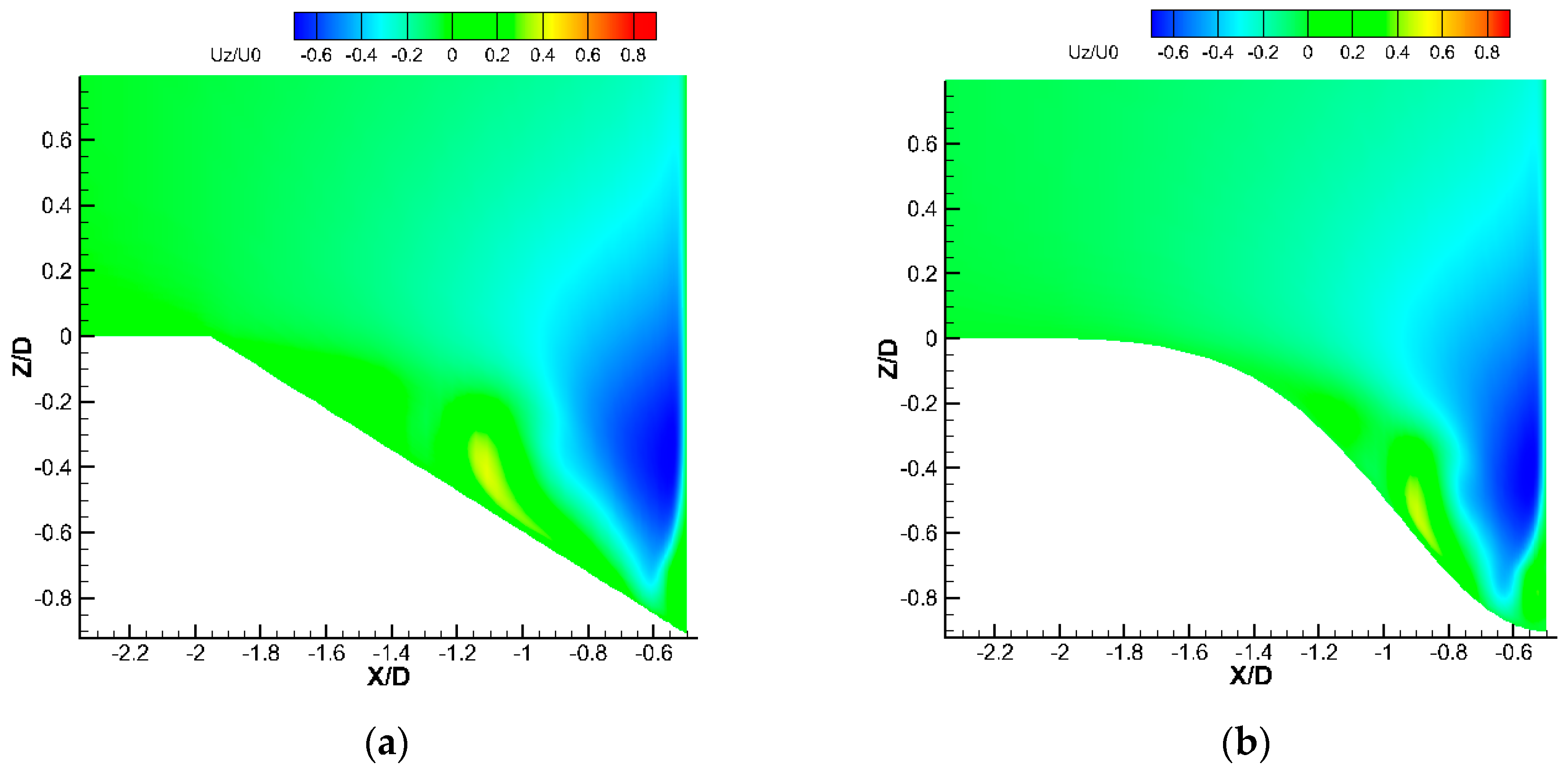

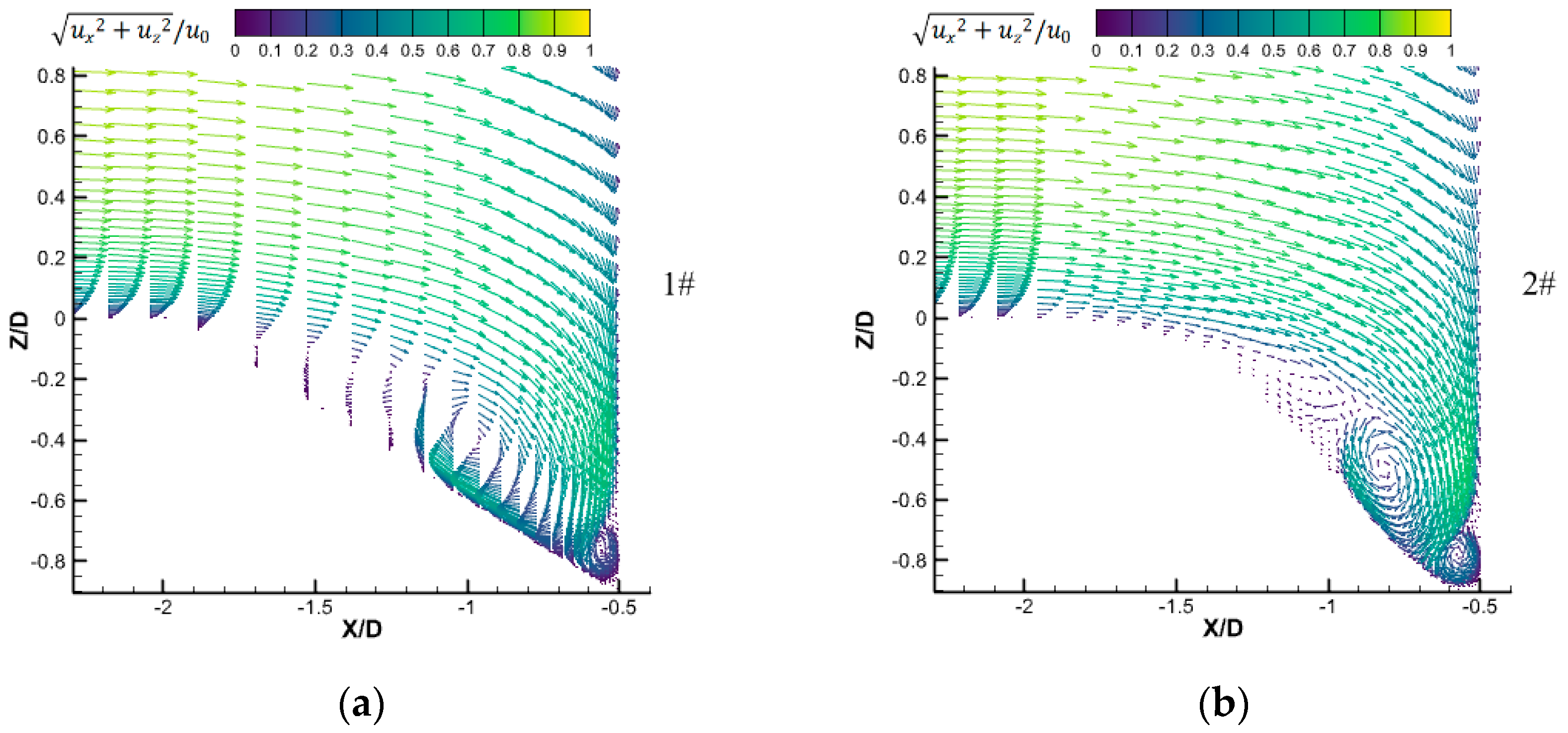


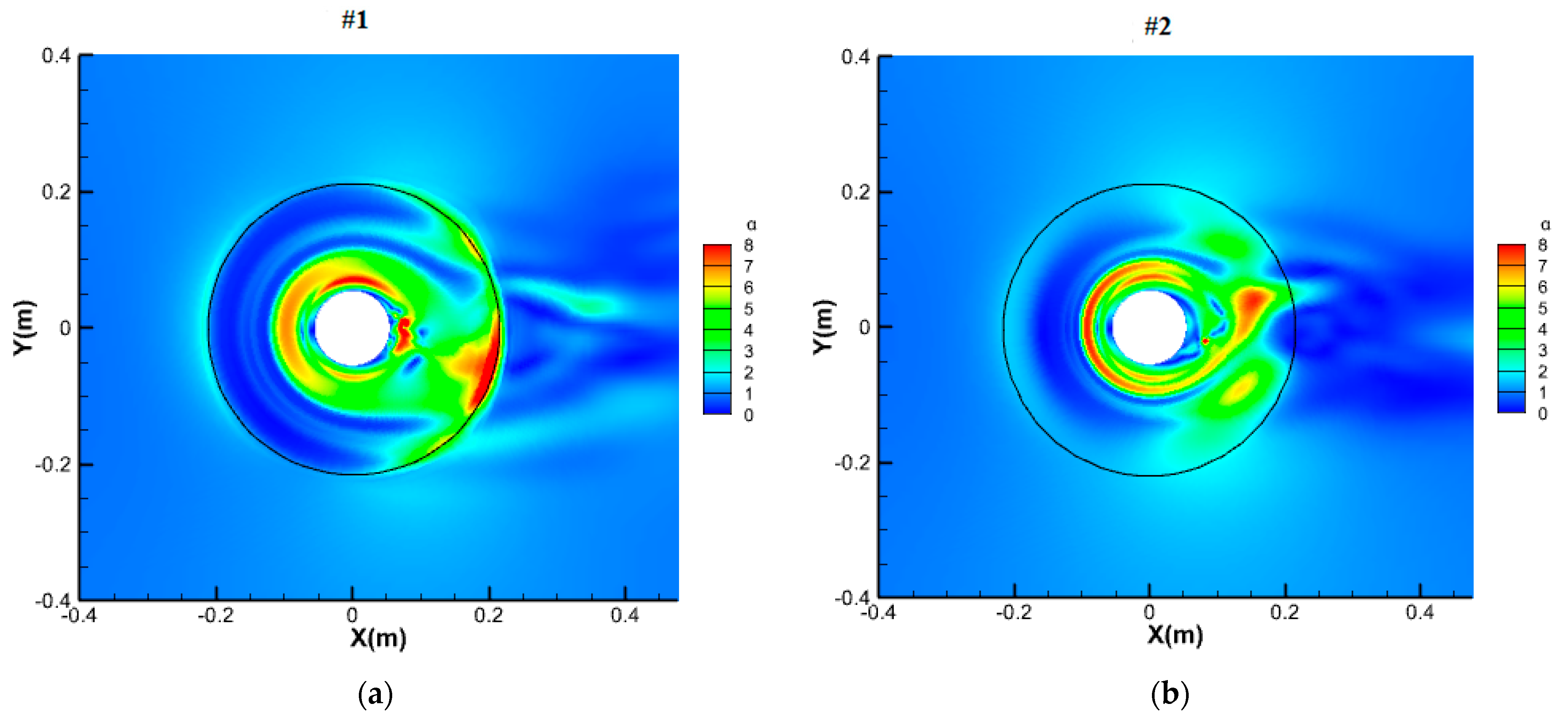
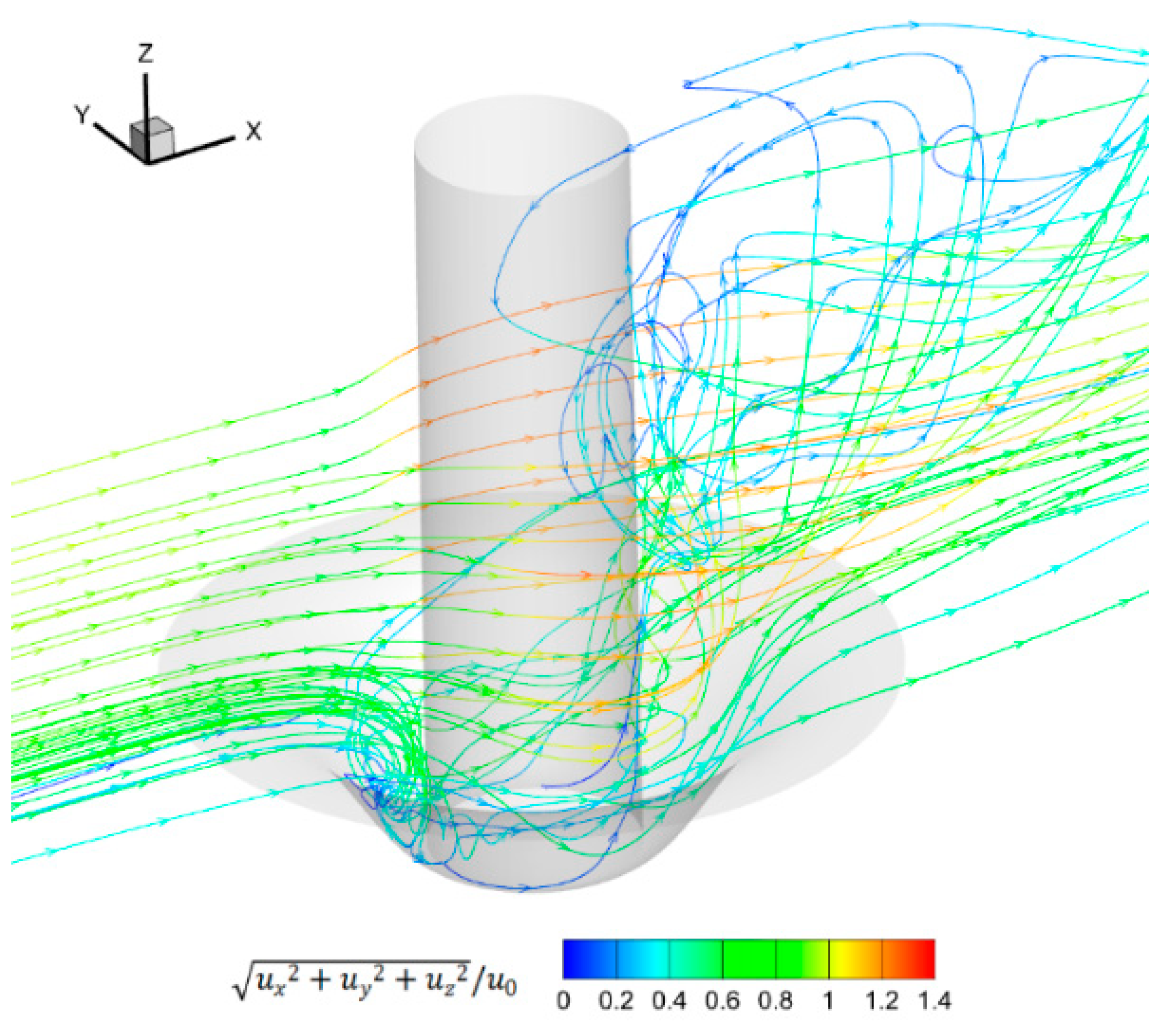

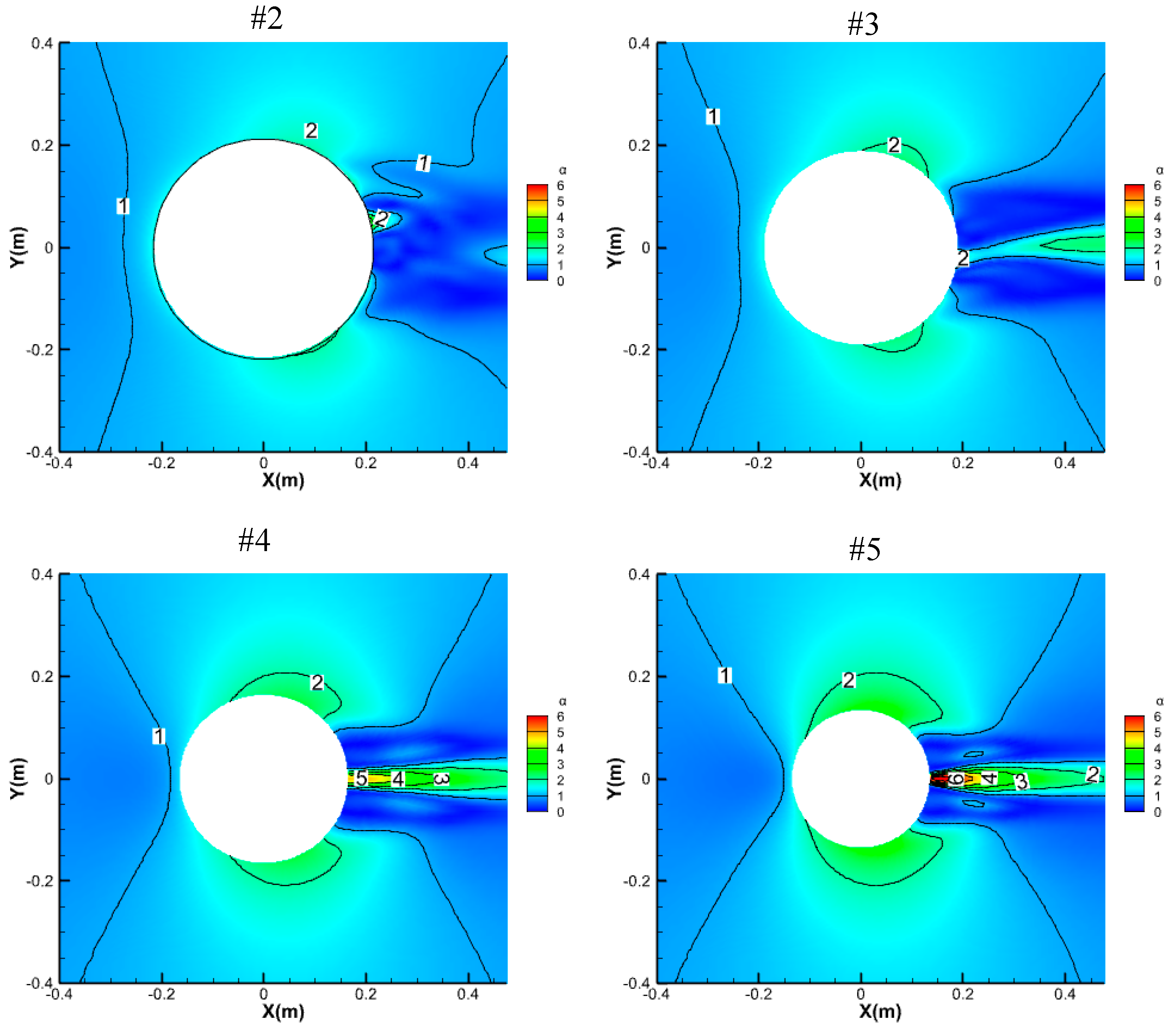
| Conical Surface | BND | ||||
|---|---|---|---|---|---|
| Scheme | #1 | #2 | #3 | #4 | #5 |
| W | 3.9D | 3.9D | 3.5D | 3D | 2.5D |
| k | - | 1.25 | 1 | 0.68 | 0.5 |
| σ | - | 0.5 | 0.4 | 0.27 | 0.2 |
Disclaimer/Publisher’s Note: The statements, opinions and data contained in all publications are solely those of the individual author(s) and contributor(s) and not of MDPI and/or the editor(s). MDPI and/or the editor(s) disclaim responsibility for any injury to people or property resulting from any ideas, methods, instructions or products referred to in the content. |
© 2024 by the authors. Licensee MDPI, Basel, Switzerland. This article is an open access article distributed under the terms and conditions of the Creative Commons Attribution (CC BY) license (https://creativecommons.org/licenses/by/4.0/).
Share and Cite
Liu, J.; Li, Z.; Huang, H.; Lin, W.; Sun, Z.; Chen, F. Three-Dimensional Turbulent Simulation of Bivariate Normal Distribution Protection Device. J. Mar. Sci. Eng. 2024, 12, 602. https://doi.org/10.3390/jmse12040602
Liu J, Li Z, Huang H, Lin W, Sun Z, Chen F. Three-Dimensional Turbulent Simulation of Bivariate Normal Distribution Protection Device. Journal of Marine Science and Engineering. 2024; 12(4):602. https://doi.org/10.3390/jmse12040602
Chicago/Turabian StyleLiu, Jing, Zongyu Li, Hanming Huang, Weiwei Lin, Zhilin Sun, and Fanjun Chen. 2024. "Three-Dimensional Turbulent Simulation of Bivariate Normal Distribution Protection Device" Journal of Marine Science and Engineering 12, no. 4: 602. https://doi.org/10.3390/jmse12040602




